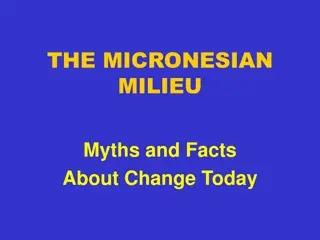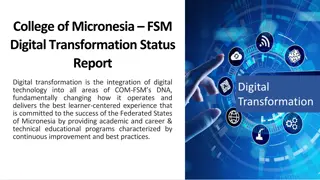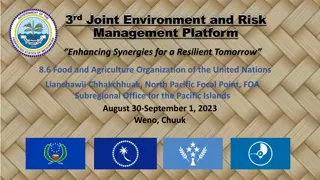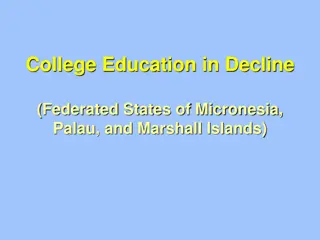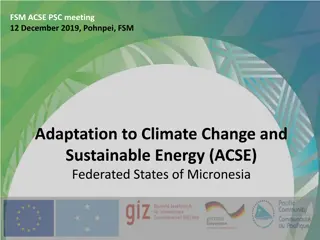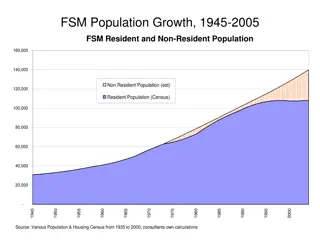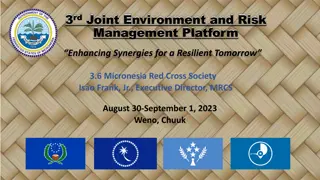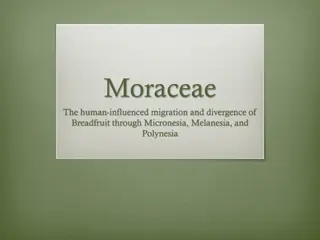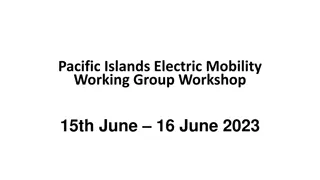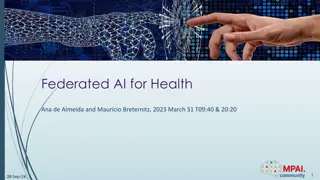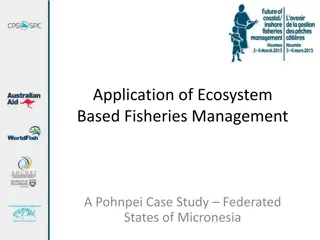Energy Sector Overview in the Federated States of Micronesia
The Federated States of Micronesia's energy sector is focused on improving citizens' lives with affordable, reliable, and environmentally sound energy. The National Energy Policy targets increased use of renewable sources, energy conservation, and efficiency standards by 2020. Despite challenges like dependency on imported fuels, the FSM aims to enhance energy production and distribution for social and economic development.
Download Presentation

Please find below an Image/Link to download the presentation.
The content on the website is provided AS IS for your information and personal use only. It may not be sold, licensed, or shared on other websites without obtaining consent from the author.If you encounter any issues during the download, it is possible that the publisher has removed the file from their server.
You are allowed to download the files provided on this website for personal or commercial use, subject to the condition that they are used lawfully. All files are the property of their respective owners.
The content on the website is provided AS IS for your information and personal use only. It may not be sold, licensed, or shared on other websites without obtaining consent from the author.
E N D
Presentation Transcript
Flag of the Federated States of Micronesia.svg Energy Sector Overview Federated States of Micronesia Department of Resources & Development Division of Energy FSM National Government
Federated States of Micronesia Federated States of Micronesia 1.3 mil sq. mile geographical area 271 sq. mile land mass 607 islands (74 inhabited islands) 102,843 total population (2010 census) + approximately 49,700 residing abroad
National Energy Policy Adopted October, 2012 To improve the life and livelihood of all FSM citizens with affordable, reliable and environmentally sound energy. To become less dependent on imported sources of energy by: - (1) increased share of renewable energy sources - (2) cross-sectorial energy conservation; and - (3) efficiency standards in place By 2020 - 30% of total energy production in RE - 50% improvement in Energy Efficiency - 90% electricity access
Energy Sector Overview Energy: integral for social and economic development Policy addresses almost entirely on electricity (transport and others not developed yet) FSM s dependency on imported fuels to meet overall energy requirements: Fuel imports 15% of GDP Imported petroleum supports 55% of households
Energy Use Distribution 10% 12% 39% 1 2 3 4 5 17% 22% 1. Utilities 4. Commercial & Industrial 2. System Losses 5. Residential 3. Government
FSM Energy Profile State Base (Diesel) KW Capacity Peak (Diesel) KW Capacity RE (done) KW Capacity RE (On going) KW Capacity Total RE KW Capacity Kosrae 600 1,200 353 6 359 (05%) Pohnpei 3,300 5,800 1,763 -0- 1,763 (05%) Chuuk 1,500 2,500 355 435 790 (05%) Yap 1,500 2,800 674 1,125 1,799 (17%) Total 6,900 12,300 3,145 1,566 4,711 (08%) Renewable Target 30% Need 4 MW (net) or about 20 MW (Solar PV) installed
Constraints & Challenges Separate state-owned power utility for each of the 4 states Coordination of Energy Development (1 National Policy w/5 Action Plans) Limited domestic capacity Access Expansion (social responsibility vs. sustainability cost) - Strong political will to push access but reluctance to support tariff to address sustainability of system. Utilities unable to generate revenue to support further energy source development (limited resources to finance RE targets) Land and infrastructure issues/limitations Logistics expensive Flag of the Federated States of Micronesia.svg
Expectation from Workshop Learn best practices from other (countries) in addressing similar or common challenges Learn strategies utilized by others in advancing their targets (RE, EE, Access, etc.) Gain better understanding of assistance offered by Government of Japan In sharing our situation, discuss how and where IRENA could offer technical support Employ knowledge gained to help improve our share of the global outreach.



